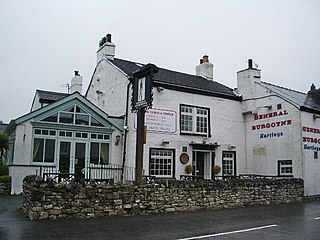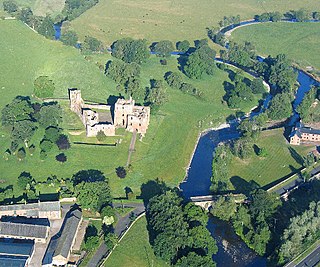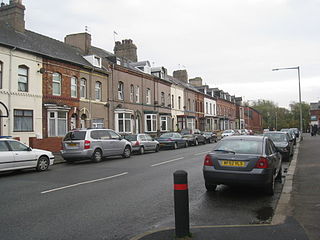
Kirkby Lonsdale is a town and civil parish in the Westmorland and Furness district of Cumbria, England, on the River Lune. Historically in Westmorland, it lies 13 miles (21 km) south-east of Kendal on the A65. The parish recorded a population of 1,771 in the 2001 census, increasing to 1,843 at the 2011 Census.

Furness is a peninsula and region of Cumbria, England. Together with the Cartmel Peninsula it forms North Lonsdale, historically an exclave of Lancashire. On 1 April 2023 it became part of the new unitary authority of Westmorland and Furness.

Urswick is a civil parish that includes the villages of Great Urswick and Little Urswick. It is located in the Furness area of Cumbria, England. The villages are situated to the south-west of the town of Ulverston. In the 2001 census the parish had a population of 351, decreasing at the 2011 census to 1,397.

Backbarrow is a village in the Lake District National Park in England. It lies on the River Leven about 5 miles (8 km) northeast of Ulverston in Furness in the county of Cumbria.

Dalton Castle is a grade I listed 14th-century peel tower situated in Dalton-in-Furness, Cumbria, England, and in the ownership of the National Trust. It was constructed by the monks of Furness Abbey for the protection of the nearby market town, and was the building from which the Abbot administered the area and dispensed justice.

The River Lowther is a small river which flows through limestone rock in Cumbria, England. It is a tributary of the River Eamont which in turn is a tributary of the River Eden which flows into the Solway Firth near Carlisle. The Lowther begins with the confluence of the Keld Gill and the Keld Dub near the village of Keld. It flows north-west until it passes between Bampton and Bampton Grange, before turning north until it flows into the River Eamont close to Penrith.

Stott Park Bobbin Mill is a 19th-century bobbin mill and now a working museum located near Newby Bridge, Cumbria, England. Built in 1835 the mill was one of over 65 such buildings in the Lake District, which provided wooden bobbins to the weaving and spinning industry primarily in Lancashire and Yorkshire. The building is today owned and run by English Heritage.

Abbey House on Abbey Road, Barrow-in-Furness, Cumbria, England is a Neo-Elizabethan H-plan mansion designed by Sir Edwin Lutyens and completed in 1914 as a guest house for Vickers Ltd and a flat for the Managing Director, Sir James McKechnie. In its abstracted, military echo of the Tudor style, it prefigures the style of Lutyens' Castle Drogo. In 1951, having been acquired by the County Council, Abbey House was made into an old people's home, and consequently suffered considerable neglect. Abbey House has been a Grade II* Listed Building since 1949.

Calder Abbey in Cumbria was a Savigniac monastery founded in 1134 by Ranulph de Gernon, 2nd Earl of Chester, and moved to this site following a refoundation in 1142. It became Cistercian in 1148. It is near the village of Calderbridge.

Abbey Road is the principal north to south arterial road through Barrow-in-Furness, Cumbria, England.

Parkside is an area and electoral ward of Barrow-in-Furness, Cumbria, England. It is bordered by Hindpool, Ormsgill, Hawcoat, Newbarns and Risedale and had a population of 5,742 in 2001, reducing to 5,584 at the 2011 Census. It is one of the town's most centralised wards and contains Barrow's main park, as well as the newly established Furness Academy.
The Roman Heritage Way is a long-distance path in England and Scotland. It covers parts of Cumbria, Northumberland, the Scottish Borders, and Tyneside.

The Furness Abbey Hotel was demolished in 1953, having been bombed in May 1941. Its site now forms the car park to Furness Abbey and the museum. The station at Furness Abbey also suffered bomb damage and was demolished in the early 1950s. The original station booking office and refreshment room, built in 1862, which had been attached to the hotel, survives as The Abbey Tavern, standing in Abbey Approach, Barrow-in-Furness, Cumbria, England, to the north of the remains of Furness Abbey. The current structure is recorded in the National Heritage List for England as a designated Grade II listed building.

The Barrow Jute Works was a jute and flax mill located in Barrow-in-Furness, Lancashire, England during the late 19th and early 20th centuries. The mill was built for the Barrow and Calcutta Jute Company which was founded by James Ramsden in 1870 in an attempt to diversify Barrow's economy which was heavily focused on iron and steel production. The Jute Works itself was designed by architects Paley and Austin and occupied over 12-acres with a 580 feet (177 m) facade on Hindpool Road and 360 feet (110 m) along Abbey Road. The mill was served by its own railway station on a branch of the Furness Railway which connected it to the town's docks, steelworks and cornmill.

Ramsden Hall located at 48 Abbey Road in Barrow-in-Furness, Cumbria, England is a Grade II listed former public bath house. Funded by industrialist and local mayor Sir James Ramsden it was constructed in 1872 and was relatively small in comparison to other public baths in Barrow. Despite no longer serving its original purpose Ramsden Hall stands as the only remaining example of a 19th-century public bath in the town. For a period of its history, the building served as an annexe of the adjacent Technical School although at present it is occupied by offices of the Citizens Advice Bureau.

The Central Fire Station on Abbey Road in Barrow-in-Furness, Cumbria, England is a Grade II listed former fire station that has been described by Historic England as a "well-preserved example of the first generation of fire station built specifically for motorised appliances". Constructed in 1911 and opening a year later, the building served as the town's only station until Cumbria Fire and Rescue Service completed their first new-build station on Phoenix Road in 1996. The building is noted for its striking red brick facades and buff terracotta dressings, it bears a strong resemblance to the Technical School built less than 10 years prior nearby on the opposite side of Abbey Road. The building has since been converted into a 'Bed Brigade' store.

Infield House was a large late-19th century country house located to the north of Barrow-in-Furness, Cumbria, England. Infield House was built adjacent to Abbey Road as a residence for businessman Samuel John Claye, the owner of Claye's Wagon Works. After Claye's death in 1886, the house and Wagon Works were sold on and later became a convalescent home. The facilities closure lead to Infield House falling into a state of disrepair and it was eventually demolished in the 1970s and replaced by a housing estate named Infield Gardens. The only remaining feature of Infield House is the boundary wall and gate piers which mark the entrance to the modern housing estate.

Winster is a village in the South Lakeland District of Cumbria, in North West England. Historically within the county of Westmorland, it is situated less than two miles east of Windermere, England's largest natural lake. The village is within the Lake District National Park. The village has a pub, the Brown Horse Inn, an 1850s coaching inn.



















